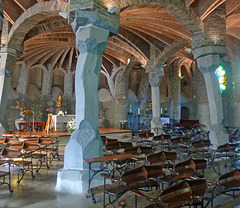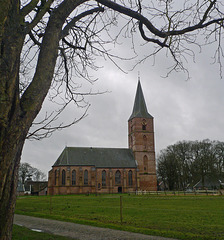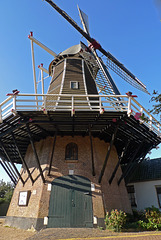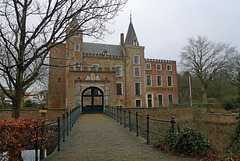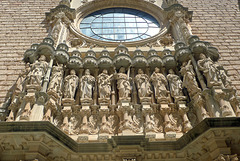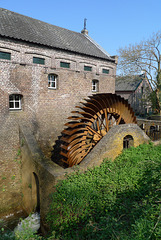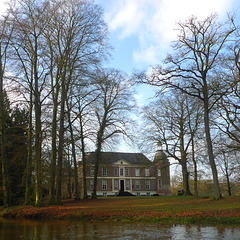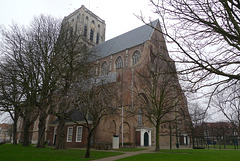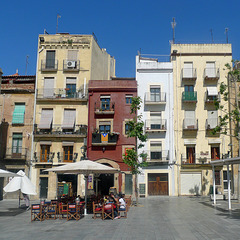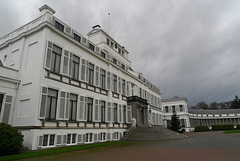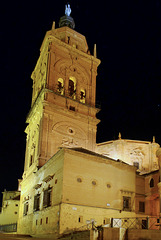Jaap van 't Veen's photos
Spain - Colònia Güell, Church
| |
|
|
|
Eusebi Güell - important industrialist - ordered in 1898 architect Antoni Gaudi to design a church for a colony - Colònia Güell - at his estate in the municipality of Santa Coloma de Cervelló.
Gaudi did a lot of studies before the building work started in 1908. The ambitious plan for a huge church with two naves (upper and lower), completed with lateral turrets and a dome of 40 metres high, remained unfinished.
In 1914 Gaudi heard that the Güell family would no longer fund the building and Gaudi abandoned the project.
One year later the lower nave was blessed by the bishop of Barcelona, which led to a church known as ‘the crypt’. Between 1915 and 1917 the upper nave was closed with brick walls and a roof.
The church - although unfinished - is commonly considered to be one of Gaudi’s masterpieces. All his architectural innovations are combined in this beautiful building.
Nederland - Staverden, watermolen
| |
|
|
|
The watermill of Staverden is located on the place of a former flour mill along the Staverdense Beek. The oldest flour mill on Staverden dates back to 1307. The mill was demolished in 1923 and two years later replaced by the present farmhouse. The waterway was restored in 1989 by a provincial foundation for preservation nature and cultural heritage called ‘Het Geldersch Landschap’, the present owner of the mill. In 2000 a small generator was attached to the waterwheel in order to generate some green electricity for the surrounding buildings.
Nederland - Rolde, Jacobuskerk
| |
|
|
|
Rolde, once the capital of the area known as the Rolderdingspel, had already a wooden church around the year of 900. Around 1200 the first stone church was built: a large Romanesque church with three naves.
Most probably the construction of the present Jacobuskerk (James Church) began in the early 15th century and was inaugurated late 1427 or early 1428 and put into use as a roman catholic church. It became a protestant church after the reformation of 1598 (nowadays both protestants and catholics are using the old building for their services).
The church has a remarkable high tower (52 meters), which is visible from far away and served in the past as a beacon for travelers to and from the city of Groningen.
During the most recent restoration (1961 – ’64), the church was thoroughly reconstructed to its original form and changes from previous renovations were undone.
The Jacobuskerk is beautifully located in the centre of Rolde, next to an old cemetery and two interesting dolmen. The church is open for visitors daily during summer season.
Nederland - Dwingeloo, Havezate Oldengaerde
| |
|
|
|
Oldengaerde is a so called ‘havezate’ - manor or fortified house - and the original building dates back to 1420. It was built by Reynolt of Echten and inhabited by the Van Echten family till 1660. That year it was sold to its son in law Cornelis van Dongen. In 1717 his son completely renovated Oldengaerde; the front became an extra floor and the current remarkable classicist façade. The garden was also constructed in a classicist French garden style.
In 1808 Havezate Oldengaerde was purchased by Aalt Willem van Holthe,; the house kept in the possession of this family for many years. During the 19th century new renovations took place, the major one was the lowering of the roof timber and the replacement of the gable by a pediment.
The owners of Oldengaerde - four daughters of Mrs. Willinge-Westra van Holthe - decided at the end of 2013 to hand over the management of the ‘havezate’ to ‘Het Drentse Landschap’, a provincial foundation for preservation of nature and cultural heritage.
Spain - Baeza, Plaza de Santa María
| |
|
|
|
The origins of Baeza date back to the first settlers during the Bronze Age, when it was a significant settlement from the Algar culture. In the Roman period a completely established town was built, including a castle and city walls. The Moors settled here and Baeza even was the capital of one of the Moorish Tarifa kingdoms.
The city became its greatest splendour during the 15th and 17th century, when its economy prospered thanks to its agriculture and the impetus of the University of Baeza.
Baeza is known as the cradle of Spanish renaissance. The UNESCO named the city a World Heritage Site in 2003.
Baeza still has a lot of important monumental complexes. The Plaza de Santa María can be considered as the heart of the city, offering most of the monuments; among them the cathedral ‘Santa Iglesia Catedral’and ‘Fuente de Santa María’.
Spain - Catalonia, Montserrat
| |
|
|
|
Montserrat is a mountain range north-west of Barcelona. Its main peaks are higher than 1.000 meters, with Sant Jeroni as highest (1,236 m). Montserrat literally means "saw mountain" in Catalan, which describes the peculiar aspect of the spectacular shaped mountains. The mountains are visible from a great distance and are part of the Montserrat National Park.
Montserrat is well known as the site of the Santa Maria de Montserrat Monastery with the Virgin of Montserrat sanctuary.
Nederland - Hattem, De Fortuin
| |
|
|
|
Hattem - a small, but old, city on the Veluwe - has had its own flour mill ever since the Middle Ages, which was very important. Whenever a city in former ages was besieged, the food supply was not supposed to be at risk. ‘De Fortuin’ (The Fortune) was (and is) located within the city walls of Hattem
‘De Fortuin’ is a so called smock mill. In 1808 the mill was blown down by a severe storm and most probably rebuilt in 1816. In 1852, according to a plaque above the entrance door, it became its brick base. In the 20th century the mill was out of use for many years. In 1970/71 it was completely restored and nowadays it is used again for grinding wheat and can be visited on Saturdays.
More info (Dutch): www.molendefortuin.nl
Nederland - Slot Haamstede
| |
|
|
|
The castle is dating back to the 13th century; the fortified tower is the only part of the original building which survived a severe fire in 1525. The castle was rebuilt in its current form in the early 17th century and much later (1973 and 1981) restored. It is now owned by ‘Vereniging Natuurmonumenten’ - a Dutch society for preservation of nature monuments.
Around the year of 1200 the castle came into the possession of Floris IV, Count of Holland. In 1229 the castle went to the Lords of Zierikzee, through an exchange with Floris IV. The new inhabitants of the castle called themselves ‘Van Haemstede’. The most famous resident was ‘Witte van Haemstede’, an illegitimate son of Count Floris V. In the mid-15th century his descendants got into financial troubles. ‘Louis de Gruuthuse’, a Flemish nobleman from Bruges, became the new owner of Castle Haamstede.
Slot Haamstede is situated in the heart of the village of Haamstede on the former island Schouwen-Duiveland. The castle itself is only open for visitors during special events. The castle woods are free accessible.
Spain - Andalusia, River Gor Valley
| |
|
|
|
The main attraction of the valley and its capital Gorafe are the almost 200 Neolithic dolmens scattered in several cemeteries around the village. It is the greatest concentration of prehistoric rests in Spain. The first human settlements date back to prehistory.
The picture shows a view from the ‘Parque Megalítico’ into the canyon of the river Gor just south of Gorafe; on the background the high mountains of the Sierra Nevada.
Spain - Catalonia, Abbey of Montserrat
| |
|
|
|
The Santa Maria de Montserrat Monastery - a Benedictine monastery about 1000 years old - is situated half way up the mountains of the Montserrat Natural Park; a mountain range with weird shaped peaks of more than 1200 meters high.
The impressive basilica is by far the most interesting of the many buildings. Within the church is the chapel with the 12th century figure of Our Lady of Montserrat - known as la Moreneta (“little dark-skinned one”) - the patron saint of Catalonia.
The Basilica was greatly damaged during the war with the French (1808-1814) and could not be reconstructed until the end of the 19th century.
Picture: sculptures of Jesus Christ and the 12 Apostles on the façade of the Basilica
Spain - Catalonia, Abbey of Montserrat
| |
|
|
|
The Santa Maria de Montserrat Monastery - a Benedictine monastery about 1000 years old - is situated half way up the mountains of the Montserrat Natural Park; a mountain range with weird shaped peaks of more than 1200 meters high.
The impressive basilica is by far the most interesting of the many buildings. Within the church is the chapel with the 12th century figure of Our Lady of Montserrat - known as la Moreneta (“little dark-skinned one”) - the patron saint of Catalonia.
The Basilica was greatly damaged during the war with the French (1808-1814) and could not be reconstructed until the end of the 19th century.
Picture: main altar of the Basilica
Nederland - Arcen, Wijmarsche Watermolen
| |
|
|
|
The Wijmarsche mill belonged to the estate of the Castle of ‘Heerlycheit Arcen’ and was already mentioned in documents in the year of 1498, although it then was located on a different place. Two centuries later, the mill was affected by the ravages of war and demolished in 1677. Rebuilding of the mill took place the same year on its present location.
Originally the mill building had two floors; the grain mill was located in the northern part and in the southern was an oil mill, having each their own water wheel. Early 19th century the building was extended with a third storey, executed in skillfully masonry.
In the years of 1881 – 1882 the oil mill disappeared and the flour mill was renovated again. In 1917 the mill was closed, due to strong competition from industrial mills. The building was severely damaged in World War II and fell into a ruin. The heirs of the last owner tried to restore the mill in the fifties, but due to the poor condition it failed.
In 1978 a foundation (Stichting Het Limburgs Landschap) took over the mill and in collaboration with local initiatives the restoration of the ‘Wijmarsche Watermolen’ Arcen was accomplished. In 1993 the mill could be used as a corn mill again. Nowadays the mill is leased to ‘Graanbranderij de IJsvogel’ (an alcohol distillery) and can be visited.
More info about the mill (Dutch): waterradmolens.nl/LimburgN/Arcen.htm
More info about the distillery (Dutch): www.ijsvogel.com
Nederland - Vorden, Kasteel Hackfort
| |
|
|
|
The history of Hackfort Castle is dating back to the year of 1322, when it was officially mentioned. In 1392 ‘House Hacforden’ was nothing more than just a residential tower. In the 1586 the castle was destroyed by the Spanish troops during the Eighty Year's War (the Dutch Independent War). After the liberation of the region by Prince Maurits van Oranje, the castle was rebuilt in 1598 by Borchard van Westerholt.
In 1788, Hackfort Castle underwent substantial renovations. The old gate house and outbuildings were demolished and the canals were filled in. The castle was transformed into an 18th-century manor house. Nowadays only the two thick cylindrical towers are reminders of the (former) castle.
The castle remained for centuries in the possession of the family Van Westerholt. When the last Baroness Westerholt of Hackfort died in1981, Hackfort Castle and estate were donated to Natuurmonumenten (Netherlands Natural Heritage Society) and the house, coachhouse (nowadays a restaurant) and watermill have since been restored and opened to the public, although with limited opening hours.
The picture is taken from the watermill: www.ipernity.com/doc/294067/26902929/in/album/537909
Nederland - Brielle, Sint-Catharijnekerk
| |
|
|
|
The Sint Catharijnekerk (also called Grote Kerk) was intended to become the largest church in the Holland region, but was never completed. The construction began in 1417, but in 1456 there was a major fire and twenty five years later they ran out of money and the construction of the church stopped; only the nave and tower were completed.
Originally it was a roman catholic church, but in the year of 1572 the parish became in Protestant hands. Despite its use by the protestants, the church is often called by its catholic name Sint Catherijnekerk (St. Catharine Church).
The Sint Catharijnekerk has quite a relationship with the House of Orange-Nassau. In the year of 1575 Willem van Oranje (William of Orange) married with Charlotte de Bourbon. And in 1688 Mary Stuart waved her husband Stadtholder William III goodbye from the tower, when he left for England to be crowned.
Brielle still can be recognized from far away by the 57 meter high, truncated tower of the Sint-Catharijnekerk. In the older days - when Brielle was a major seaport - the tower also was used as a lighthouse.
Spain - Tarragona
| |
|
|
|
Plaça del Rei is one of the cosiest squares in the old part of the city of Tarragona.
Nederland - Paleis Soestdijk
| |
|
|
|
Jacob de Graeff, mayor of Amsterdam, built around 1650 a countryhouse along a road - ‘Zoesdijc’ - between the villages of Baarn and Soest, which was called ‘Hofstede aen Zoestdijck’. Stadholder William III bought the manor in 1674 and used it as a hunting lodge.
Many members of the family of Orange-Nassau lived in ‘Soestdijk Palace’ till 1795 during the French invasion, when it was seized as a spoil of war. The building then was used by French soldiers. In 1815 the Prince of Orange, later King Willem II, was presented ‘Soestdijk Palace’, in recognition of his services at the Battle of Waterloo. The palace was expanded by adding two wings, the northern or ‘Baarn-wing’ and the southern or ‘Soest-wing’.
Many years the palace was only used as summer home by members of the Dutch royal family. After the investiture of Queen Wilhelmina ‘Soestdijk Palace’ was regularly used again. Her mother, Queen Emma, used the palace as a summer home until her death in 1934. After her death the palace was renovated so that Princess Juliana and Prince Bernhard could make it their home after their marriage in 1937. ‘Soestdijk Palace’ became in 1948 their official residence until both of their deaths in 2004.
Pending a decision about its future use, ‘Soestdijk Palace’ is a kind of a museum and it is possible to visit the building and the surrounding gardens.
Spain - Guadix, Cathedral
| |
|
|
|
The Cathedral of Guadix (Catedral de la Encarnación de Guadix) is a Roman Catholic cathedral. The baroque style building was under construction for a long period; it began in the 16th century and was completed in the mid-18th century.
Guadix is believed to be one of the oldest diocesan seats in Spain. The cathedral stands on the site of an earlier Visigoth church extant in the 10th century, upon which - during the period of Muslim domination - a mosque was built. Guadix was captured by the Christian forces in 1489 and the Visigoth church was reestablished as the official seat of a bishop. It was given the name of the “Church of Saint Mary of the Incarnation” (Iglesia de Santa María de la Encarnación) and later was made a cathedral by a bull of Pope Innocent VIII.
Nederland - Slochteren, Fraeylemaborg
| |
|
|
|
More than seven centuries ago farmers who lived in the neighbourhood needed to protect their crop and themselves and they built a strong stone house (in the Dutch province of Groningen they were called ‘borg’). They were inspired by local monks who started building their monasteries with bricks. Besides churches, these structures were the only buildings that used durable stone and masonry.
In 1475 there was already a farm with the name Frealemaheerd. Times were turbulent and unsafe in this part of the country. The ‘borg’ had to be fortified with a moat and extra walls. About 150 years later the house received its current name ‘Fraeylemaborg’, when it became permanently inhabited by the Fraeylema family.
Through the centuries many powerful families have made the Fraeylemaborg their home. One of them, Hendrik de Sandra de Veldtman, bought the estate in 1781 after decades of neglect and decay. He restored and transformed the house to its present form. In 1972 the last private family left the Fraeylemaborg and the estate was bought by a foundation and opened the park to the public and converted the house to a museum.
The moated ‘Fraeylemaborg’ is surrounded by a beautiful country estate of over 26 hectares with a fragment of a late 17th century garden and a 19th century landscape park. During spring it offers numerous so called ‘stinsenplanten’, plants which are more or less unique for this kind of manor gardens.
Jump to top
- ipernity © 2007-2024
- Help & Contact
|
Club news
|
About ipernity
|
History |
ipernity Club & Prices |
Guide of good conduct
Donate | Group guidelines | Privacy policy | Terms of use | Statutes | In memoria -
Facebook
Twitter

